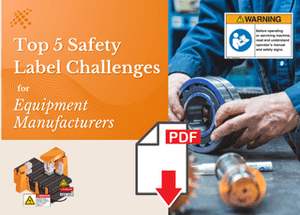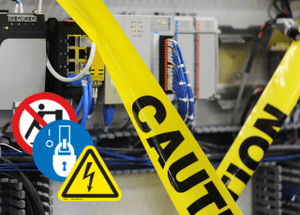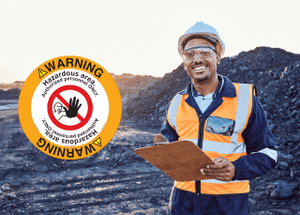Eye Safety Tips for Work

The Current State of Eye Safety in the U.S.
March has been designated as Workplace Eye Wellness Month to help promote eye safety. It’s a good time for employers to examine their workplace safety protocols and for equipment manufacturers to ensure their risk assessment processes are thorough and address potential eye hazards where applicable. 20,000 workplace eye injuries happen every year in the United States, resulting in $300 million lost in worker compensation, medical treatment, and productivity. To drill down these statistics even further, 2,000 workers sustain a job-related eye injury each day according to the Health & Safety Institute. It’s vital for everyone working in potentially dangerous environments to know how these injuries typically occur and how to prevent them from happening in the first place. Throughout the month of March, the nonprofit organization Prevent Blindness will be providing free resources for workplaces and employers to help spread awareness.
Eye Protection: Injury Prevalence and Common Hazards
As it did in 2023, eye and face protection made OSHA’s 2024 top 10 violations list, an update of the most frequently cited safety violations from the previous year. OSHA recorded over 1,800 violations pertaining to the misuse or nonuse of required eye and face PPE, numbers that still are on the rise steadily since 2018.
There are several occupations that are considered to have a higher risk for eye injuries, including construction, carpentry, welding, manufacturing, plumbing, electrical work, and automotives, as these industries require the use of machinery and equipment that generate dust and other debris that can cause damage to the eyes. Eye injuries, even minor ones, can result in lifelong vision issues.
Common eye hazards include:
- Getting a metal sliver in the eye due to hammering on metal.
- Getting particles of wood, slag, cement, or drywall in the eye due to carpentry.
- Handling chemicals that splash into the eyes.
- Sanding, grinding, or other masonry work that can create particles.
- Welding that exposes the eyes to flashes and arcs.
- Getting wet cement in the eye, resulting in chemical burns.
Eye Safety Tips for Workplaces and Equipment
By enforcing eye protection safety measures, injuries can be reduced. In the workplace, employers should look at their operations to see which areas are most prone to eye injuries. There must be mandatory eye protection protocol, in line with the specific hazards and duties present, in every single area of the workplace; it should be routinely reviewed and revised. All employees should also know what to do in the event of an eye injury. Employers should make this training part of new hire orientation. First aid kits should be located throughout the building as well as eyewash stations. These stations are particularly important in areas where workers could be exposed to chemicals. A copy of your workplace eye wellness program should be readily available where all employees can see it.
For equipment being designed and manufactured, it’s critical to perform a risk assessment on the product during its various design phases. That’s an essential part of nearly every product manufacturer’s development process and for good reason. Risk assessment is all about identifying possible hazardous situations that could occur during your product’s lifecycle and then finding ways to eliminate or reduce the risks associated with those hazards. If potential eye hazards can be identified early on, either eliminated or guarded against, safety can be increased.
Eye Protection in the Cyber World
In an increasingly digital world, workspaces are transitioning to having more computer based roles and remote employees. This means that even those who are not around seemingly dangerous work hazards can still be at risk for eye injuries. The most common of these being computer vision syndrome, which is caused by too much screentime without breaks. This can cause headaches, inattentiveness, neck pain, back pain, blurred vision and dry eyes. Data from the 2025 Workplace Vision Health Report displayed that nearly 6 out of 10 employees say digital eye strain reduces their productivity and effectiveness at work.
A few ways to decrease avoidable eye strain in digital workspaces is to incorporate the following methods into your work routine:
- Either decrease your screen time or find ways to incorporate short breaks where you are not looking at a screen. This means that you shouldn’t be spending downtime looking at a phone or TV when not at the computer, but something with no digital interface. Every 20 minutes, you should try and look away from your monitor and focus on an object for 20 seconds to decrease strain.
- Enable blue light screen or anti-glare screens on your computer screens, smart phones, and tablets to decrease the blue light amounts reaching your eyes.
- Your computer screen should be places below eye level and 20 to 26 inches away from your eyes.
Workplaces with large quantities of office based and remote staff should remind their employees to follow these easy, yet effective eye safety tips while working at a computer.
Eye and Face Protection Standards – and PPE
OSHA standard 1926.102 requires that employers ensure that their employees use appropriate eye or face protection when exposed to eye or face hazards from flying particles, molten metal, liquid chemicals, acids or caustic liquids, chemical gases, or vapors, or potentially injurious light radiation.
To prevent eye injuries, workers should have five types of personal protective equipment or PPE present. This includes general safety glasses, which can be in the form of safety goggles or hybrid safety glasses. This is the ideal form of protection to prevent dust, drywall, and other particles from getting into the eyes. Employers should invest in glasses that come with anti-fogging capabilities. Ideally, the glasses will have rubber or foam around the lenses to prevent the particles from reaching the eyes another way.
Faceshields are highly useful in preventing bloodborne, chemical, and high-impact hazards. Some even come with a metal coating to protect against heat. Welding eye protection is essential when employees will work with intense heat. In some workplaces, full-facepiece respirators may be necessary. These offer protection for the eyes in the presence of chemicals, dust, and smoke. A combination of some of these devices may be necessary to ensure employees are safe.
Benefits of Warning Labels, Signs, and Tags
Effective labels, signs, and tags – ones that use today’s best practices and are in line with ANSI and ISO standards – are an important way to communicate about hazards and remind about the necessity to use safety equipment to avoid injuries.
When employers require their workers to use PPE, safety signs become an integral part of their PPE program. Notice and safety instruction signs can help support company policies and PPE signs, including eye and face protection signs, serve as visual reminders that reinforce specific PPE training and compliance.
At the same time, from a product safety perspective, PPE labels on equipment communicate about the need to use PPE by those who install, operate, service, and dispose of the product. That type of information is a key factor in fulfilling a manufacturer’s legal duty to warn.
Prepare Your Products and Workplace for Eye Safety
Eye injuries can affect employees for the rest of their lives – and have serious liability impacts for businesses. The goal for us all is to have zero eye injuries. Working together, that is entirely feasible. At Clarion Safety, we’re here to help. Get in touch with us to see which labels, signs, and tags are right for your project. We can also assist with machinery risk assessments for OEMs and workplaces, along with label consultations.
If you’re ready to order your warnings, browse our line of visual communication safety products, or create your own with our fast and easy to use online customization tools; whether it’s a ‘Danger’, ‘Warning’, ‘Caution’, ‘Notice’ or ‘Safety Instructions’ message – we have you covered!
This blog was originally posted on 3/14/19 and has been updated with new information throughout.



